Chemical Resistant Gloves Are Critical For Full Protection
Chemicals are a necessary part of many of employers’ operations. We try to protect our employees the best that we can by substituting less dangerous chemicals when possible, engineering controls to minimize exposures, and implementing administrative controls to further reduce exposures. Despite those controls, though, employees still are exposed to severe health hazards from those chemicals, which can include burns, central nervous system damage, organ failure, sterility, blindness, cancer, or even death. When exposures exist, we have a moral and legal obligation to protect our workers from those hazards. The last line of defense that we can offer them is their personal protective equipment (PPE).
Chemical resistant gloves are essential to protecting employees from hazardous and toxic chemical exposures. They are the final barrier between the employee and a potentially fatal health hazard. Exposures to acids can lead to burns, or even dissolve the employee’s flesh. While this gruesome thought might be the most obvious example of a chemical hazard, it is not the only hazard, nor is it the worst. Some chemicals can pass through a person’s skin, entering their bloodstream and making their way to vital organs. Victims of these exposures are not always immediately aware there is a problem; they might have only had a small rash or a bit of discomfort where the chemical contacted their skin. What they may not be aware of, though, is the internal damage that the chemical is causing to their bodies. Cancer cells may begin to grow and spread rapidly; tissues in their lungs, heart, kidneys, or liver may be destroyed or mutated, laying the groundwork for organ failure in the future. Some exposures may take years for the symptoms to develop, and for the damage to be identified.
Understanding the severity of the hazards that our workers face, we need to ensure that their PPE properly protects them from those hazards. This starts with reviewing the specific chemical’s safety data sheet. It provides extensive information about the hazards, make up, and how to respond to and treat exposures. It also indicates what PPE is required when working with the chemical. This information can be found in section 8 – Exposure Controls and Personal Protection. When gloves are required, the safety data sheet will also indicate the right type of glove. Chemical resistant gloves are made of different materials that each react to chemicals differently, so there is not one type of glove that protects against every chemical exposure. Providing the wrong glove can have dire consequences for the employees who trust us to protect them.
Gloves are not all the same. Thicker gloves resist chemicals better, but can also affect a person’s grip and dexterity, leading to other safety concerns. The glove material can affect its protection and resistance, too. Some common materials include:
Butyl – synthetic rubber that offers good protection against peroxides, highly corrosive acids, strong bases, ketones, esters, and nitro-compounds. Butyl holds up well to oxidation and abrasion, and works well in cold temperatures because it does not stiffen.
- Latex – generally found to be comfortable, and make a good general-purpose glove. They offer good protection from water solutions of acids, alkalis, salts, and ketones, have good elasticity, and function well in hot and cold environments. Latex allergies can prevent them from being used by some employees.
- Neoprene – very dense and resists tears well. It also is very pliable, and allows for better fine manipulation. Generally considered to be superior to latex.
Our duty extends beyond merely providing PPE to our employees; we must ensure that they understand the hazards that they are exposed to, and how to use, maintain, and store their PPE. This can only be accomplished through training.
Because of the severe health hazards that chemicals present, chemical resistant gloves should always be inspected before they are used. Discoloration, wear, degradation, and punctures can all be signs that the glove is compromised, which could allow chemicals to seep through the glove and contact the employee’s skin. Filling the glove with air, then sealing it by rolling the gauntlet towards the fingers, and then pressing on it firmly is a way to detect punctures or wear that are not clearly visible to the naked eye.








